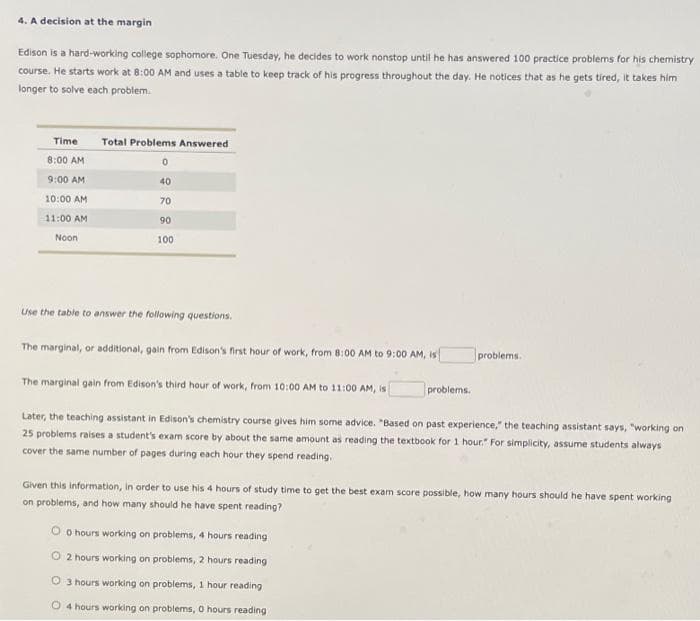4. A decision at the margin Edison is a hard-working college sophomore. One Tuesday, he decides to work nonstop until he has answered 100 practice problems for his chemistry course. He starts work at 8:00 AM and uses a table to keep track of his progress throughout the day. He notices that as he gets tired, it takes him longer to solve each problem. Time Total Problems Answered 8:00 AM 0 9:00 AM 40 10:00 AM 70 90 11:00 AM Noon 100 Use the table to answer the following questions. The marginal, or additional, gain from Edison's first hour of work, from 8:00 AM to 9:00 AM, is problems. The marginal gain from Edison's third hour of work, from 10:00 AM to 11:00 AM, is problems. Later, the teaching assistant in Edison's chemistry course gives him some advice. "Based on past experience," the teaching assistant says, "working on 25 problems raises a student's exam score by about the same amount as reading the textbook for 1 hour." For simplicity, assume students always cover the same number of pages during each hour they spend reading. Given this information, in order to use his 4 hours of study time to get the best exam score possible, how many hours should he have spent working on problems, and how many should he have spent reading? 0 hours working on problems, 4 hours reading 2 hours working on problems, 2 hours reading 3 hours working on problems, 1 hour reading 4 hours working on problems, 0 hours reading
4. A decision at the margin Edison is a hard-working college sophomore. One Tuesday, he decides to work nonstop until he has answered 100 practice problems for his chemistry course. He starts work at 8:00 AM and uses a table to keep track of his progress throughout the day. He notices that as he gets tired, it takes him longer to solve each problem. Time Total Problems Answered 8:00 AM 0 9:00 AM 40 10:00 AM 70 90 11:00 AM Noon 100 Use the table to answer the following questions. The marginal, or additional, gain from Edison's first hour of work, from 8:00 AM to 9:00 AM, is problems. The marginal gain from Edison's third hour of work, from 10:00 AM to 11:00 AM, is problems. Later, the teaching assistant in Edison's chemistry course gives him some advice. "Based on past experience," the teaching assistant says, "working on 25 problems raises a student's exam score by about the same amount as reading the textbook for 1 hour." For simplicity, assume students always cover the same number of pages during each hour they spend reading. Given this information, in order to use his 4 hours of study time to get the best exam score possible, how many hours should he have spent working on problems, and how many should he have spent reading? 0 hours working on problems, 4 hours reading 2 hours working on problems, 2 hours reading 3 hours working on problems, 1 hour reading 4 hours working on problems, 0 hours reading
Principles of Economics 2e
2nd Edition
ISBN:9781947172364
Author:Steven A. Greenlaw; David Shapiro
Publisher:Steven A. Greenlaw; David Shapiro
Chapter13: Positive Externalities And Public Goods
Section: Chapter Questions
Problem 25P: Becky and Sarah are sisters 1who share a room. Their room can easily get messy, and their parents am...
Related questions
Question
M1

Transcribed Image Text:4. A decision at the margin
Edison is a hard-working college sophomore. One Tuesday, he decides to work nonstop until he has answered 100 practice problems for his chemistry
course. He starts work at 8:00 AM and uses a table to keep track of his progress throughout the day. He notices that as he gets tired, it takes him
longer to solve each problem.
Time
Total Problems Answered
8:00 AM
0
9:00 AM
40
10:00 AM
70
90
11:00 AM
Noon
100
Use the table to answer the following questions.
The marginal, or additional, gain from Edison's first hour of work, from 8:00 AM to 9:00 AM, is
problems.
The marginal gain from Edison's third hour of work, from 10:00 AM to 11:00 AM, is
problems.
Later, the teaching assistant in Edison's chemistry course gives him some advice. "Based on past experience," the teaching assistant says, "working on
25 problems raises a student's exam score by about the same amount as reading the textbook for 1 hour." For simplicity, assume students always
cover the same number of pages during each hour they spend reading.
Given this information, in order to use his 4 hours of study time to get the best exam score possible, how many hours should he have spent working
on problems, and how many should he have spent reading?
0 hours working on problems, 4 hours reading
2 hours working on problems, 2 hours reading
3 hours working on problems, 1 hour reading
4 hours working on problems, 0 hours reading
Expert Solution
This question has been solved!
Explore an expertly crafted, step-by-step solution for a thorough understanding of key concepts.
This is a popular solution!
Trending now
This is a popular solution!
Step by step
Solved in 2 steps

Knowledge Booster
Learn more about
Need a deep-dive on the concept behind this application? Look no further. Learn more about this topic, economics and related others by exploring similar questions and additional content below.Recommended textbooks for you

Principles of Economics 2e
Economics
ISBN:
9781947172364
Author:
Steven A. Greenlaw; David Shapiro
Publisher:
OpenStax

Principles of Economics 2e
Economics
ISBN:
9781947172364
Author:
Steven A. Greenlaw; David Shapiro
Publisher:
OpenStax